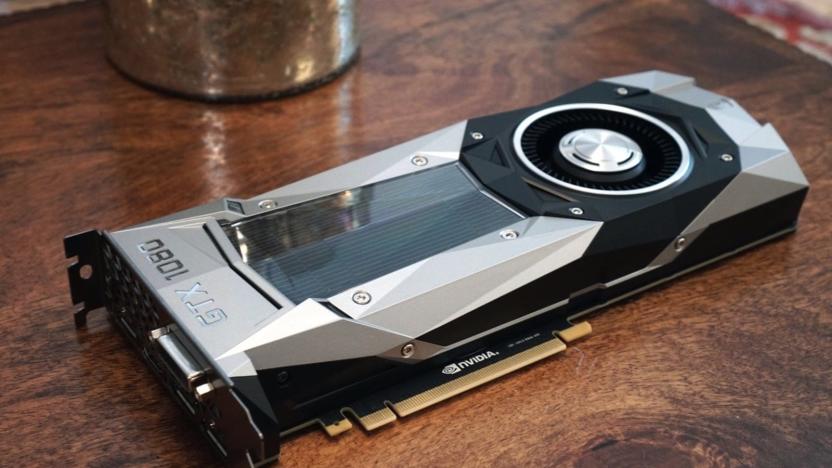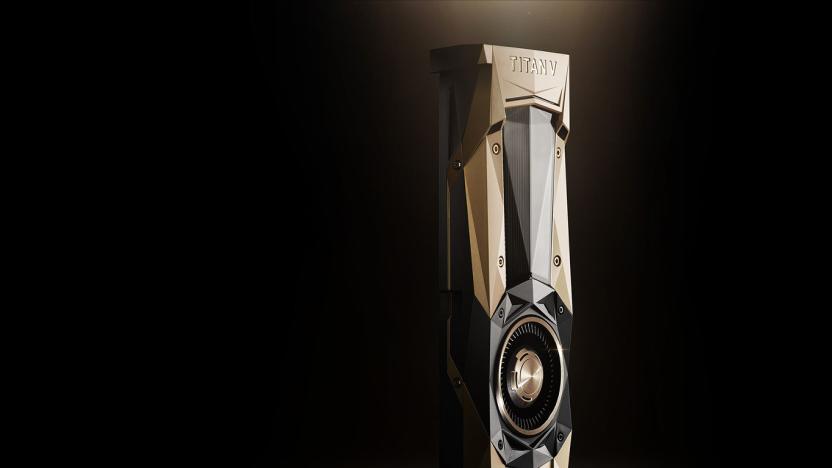GTX
Latest

NVIDIA shows how much ray-tracing sucks on older GPUs
NVIDIA recently announced that ray-tracing is coming to older Pascal GPUs, and now it has detailed how well -- or not well, rather -- it will actually work. If you're happy with basic effects, the news isn't too bad. The RTX 2080 Ti will outperform its 1080 Ti counterpart by just over double for reflections, in line with what you'd expect for a next-gen card. However, for stuff that really adds realism, like advanced shadows, global illumination and ambient occlusion, the RTX 2080 Ti outperforms the 1080 Ti by up to a factor of six.

NVIDIA's ray tracing tech will soon run on older GTX cards
NVIDIA has announced that its ray-tracing tech, only available on its new RTX cards so far, is coming to its older GeForce GTX 10-series cards in April. The technology will work on GPUs from the GTX 1060 and up, albeit with some serious caveats. Some games like Battlefield V will run adequately at low settings, but other games, like the freshly released Metro Exodus, will run at just 18 fps at 1440p -- obviously an unplayable frame-rate.

Vauxhall's GTX concept teases the future of mass-market EVs
Vauxhall and Opel, the Anglo-German car maker, joins a number of companies suddenly rushing to embrace electrification. As part of a wider shift away from gas-powered vehicles, it has built the GTX, an all-electric concept that serves as a mission statement for its EVs. You won't see this car popping up in showrooms, but this is the shape, broadly, of things to come.

NVIDIA announces exclusive features for GPUs that don't exist
It's been exactly five years since NVIDIA announced Volta, its next-generation GPU architecture. The closest thing to a Volta consumer graphics card we've seen since is the Titan V, a $3,000 offering targeted at scientists that was announced three months ago. Well, today at GDC, NVIDIA is... still not announcing a new GeForce card based on Volta. What it's doing instead is teasing that Volta cards will have some exclusive GameWorks features. The new features are part of "RTX," a "highly scalable" solution that, according to the company, will "usher in a new era" of real-time ray tracing. Keeping with the acronyms, RTX is compatible with DXR, Microsoft's new ray tracing API for DirectX. To be clear, DXR will support older graphics cards; it's only the NVIDIA features that will be locked to "Volta and future generation GPU architectures."

Thin gaming laptops will run VR with NVIDIA's new chip
Nvidia has just taken the wraps off a trio of laptop GPUs based on its new "Pascal" chip architecture, the GeForce GTX 1060, the 1070 and the 1080. While the 1080 is by far the most impressive, it's the humble 1060 that could make the biggest impact on the market. Why? Because it facilitates using a virtual reality headset like the HTC Vive or the Oculus Rift on a reasonably small laptop.

NVIDIA Titan Black cards bring much improved specs, even crazier prices
That's right, a thousand dollars is just the starting price for the new Titan Black, which surpasses and replaces the original $999 GTX Titan that came out last year. Thanks to a more overclock-friendly version of NVIDIA's "Big Kepler" silicon, card vendors are offering custom-cooled versions of the Titan Black that go way beyond the 889MHz reference design, with monetary premiums to match. EVGA looks to be bringing out a 1GHz "HydroCopper" variant, for example, which will likely fetch in the region of $1,100 -- just reasonable enough, in a twisted sort of way, to make you question whether buying a base card might be selling yourself short. But the Titan Black is about more than just clock speeds. It adopts the gaming-focused features of the $699 GTX 780 Ti, including a full quota of 2,880 stream processors and 240 texture units, and it combines them with the 6GB of GDDR5 and double precision floating point performance that made the first Titan so good at semi-professional GPU compute tasks (just below the level of a Tesla). We haven't seen many reviews yet, aside from one saucy piece of literature that looked at four Titan Blacks side-by-side in SLI mode, but it looks like NVIDA might have finally hit on a solid product for those of us who want to mix business with pleasure.

NVIDIA's GTX 650 Ti Boost lives up to its name for $149
By NVIDIA's own admission, the lower registers of its Kepler-based GeForce graphics cards "couldn't always tackle [their] originally stated goal" of powering 1080p games with the settings amped up to high. So, after the GeForce GTX 650 and 650 Ti, maybe the third time's a charm. The latest card goes by the name GTX 650 Ti Boost, reflecting the fact that it brings NVIDIA's GPU Boost technology into the mix, which can vary the chip's clock speed as need allows. Stacked against the 650 Ti, this unit's got 782 CUDA cores (up from 768), a base clock of 980MHz (up from 928MHz) and a TDP of 140W, (compared to 110W). Another big draw is two-way SLI, so you can pair up cards when your wallet regains its strength. On the benchmark front, NVIDIA promises you can run Starcraft 2: Heart of the Swarm at highest settings and get a frame rate of 62fps, an order of magnitude higher than the 39fps promised on the 650 Ti. Sitting above the 650 Ti and below the GeForce 660, the 1GB version will set you back $149 (£124), with the 2GB edition priced at $169 (£144). In behind-closed-doors tests, the company has found that it comes out on top against AMD's $249 Radeon 7850, but we'll be rounding up independent reviews shortly in order to verify that claim -- as well as seeing if it can make the 7790 think twice about getting out of bed. %Gallery-183823%

NVIDIA announces special edition GTX 560 Ti with 448 CUDA cores, available now for $289
Now that we're officially in the throes of holiday shopping season, NVIDIA's rolling out a promotion of its own, though sadly it doesn't involve any steep discounts. The outfit just announced a special edition GPU: the GTX 560 Ti with 448 CUDA cores, running at 1.46GHz, a 732MHz graphics clock and 1.25GB of GDDR5 memory charging ahead at an effective rate of 3.8GHz. Other features include support for three-way SLI, DisplayPort, HDMI and DVI. Those specs place it snugly between the current GTX 560 Ti with 384 CUDA cores, and the higher-end GTX 570, which packs 480. If this seems like a puzzling move, it is indeed the first time NVIDIA's bothered with a limited holiday edition card, though in conversations with reporters the company made it clear its new hardware is meant to dovetail with the arrival of games like The Elder Scrolls V: Skyrim, Battlefield 3 and Batman: Arkham City. If you're shopping for a gamer (or, you know, yourself), it's available now for $289 in the US, Canada, UK, France, Germany, Russia and Nordic countries through companies like ASUS, MSI and Gigabyte, among others. Update: Looks like the reviews are rolling in! We've linked a handful of 'em below.

ASUS Mars II and Matrix GTX580 Platinum eyes-on
If you thought the original Mars graphics card from ASUS was a little bit ridiculous, get ready to see what a lot of ridiculous looks like. The company's Mars II that was recently teased alongside a fresh new Matrix GTX580 Platinum card, squeezes two GeForce GTX 580 chips on the same board and overclocks them for good measure. In order to achieve such great feats, the card requires no less than three 8-pin auxiliary power connectors and takes up the space of three (2.6, to be precise) PCI slots with its ginormous dual-fan cooler. Heatpipes are also employed to keep the raging fires within in check, and -- for situations where all else fails -- ASUS has installed a special red button that sends the fan into full speed when depressed. ASUS hasn't yet finalized how far above the default engine clock speeds the Mars II will reach, but it has a bit of time to figure that out as this extremely limited edition card is coming sometime in July. Buyers in the US, Europe and Asia-Pacific region will have to be quick on their credit card trigger, as only 1,000 Mars IIs will ever be produced. Oh, and if you're wondering how much power a dual-GTX 580 graphics card might consume, the answer is 600W. All by itself. %Gallery-125006% Also making its debut at Computex this week is ASUS' latest offering for the truly overclock-mad PC gamer: the Matrix GTX580 Platinum. Frankly, it feels barren by comparison to its Martian sibling, coming with just one GTX 580 graphics processor, albeit an overclocked one, and the requirement for only two 8-pin connectors for added power. ASUS has thrown in a pair of physical "plus" and "minus" buttons, which permit voltage alterations on the fly, added the same fan override key as on the Mars II, and included a Safe Mode switch at the back in the event that you get carried away with your tweaking. Mashing that last button will reset all clock speeds, voltages and other settings to their default values, which should hopefully let you boot back up and try again. A final note of merit goes to the LED-infused Matrix logo atop the GTX580 Platinum. It's not there just for decorative purposes; its color changes in response to the load the GPU is under, so that blue and green will tell you there are no worries and orange and red will indicate you're cranking it close to its limits. The GTX580 Platinum should start selling worldwide next week, though pricing has yet to be announced. Check it out in closer detail in the gallery below. %Gallery-125008%

ASUS Matrix GTX 580 and MARS II desktop graphics cards revealed, devour PCI slots
With all the talk of ASUS's tablets recently it's easy to forget the company also dabbles in graphics cards, some large enough to blot out the sun. We've got some details on its latest contestants for your PC gaming dollar, the MARS II and Matrix GTX 580 (above), and you might have to buy a new case just squeeze these unwieldy pixel-pushers inside. The Matrix will come in two flavors -- standard and Platinum -- both with 1.5GB of RAM and an enormous dual-fan cooling solution that eats up a jaw-dropping three PCI slots. But, hey, it should afford you some serious overclocking headroom. Though we've yet to seen any pics of the MARS II, the 3GB, dual-GPU behemoth is bound to be even more massive -- we wouldn't be surprised if ASUS had to provide a breakout box for whatever cooler it strapped to those pair of GTX 580 cores. Prices and release dates are still up in the air, but we're sure all will be revealed during the official announcement at Computex. Check out the image after the break for more detailed specs. [Thanks, Robert and Alexandre]

ASUS refreshes Lamborghini VX7 with Sandy Bridge, mercifully offers a black option
Just in time for spring, ASUS has refreshed its Lamborghini VX7, a staple in the company's line of premium notebooks (and fugly smartphones) inspired by the storied Italian car maker. Available in orange and a more staid black, this 8.4-pound beast packs a quad-core Sandy Bridge Intel Core i7 processor, Full HD 15.6-inch display, discrete NVIDIA GeForce GTX 460M graphics with 3GB of video memory, up to 16GB of RAM, an 8-cell battery, one USB 3.0 port (along with three USB 2.0 ones), HDMI output, a 2 megapixel webcam, and hard drive space ranging from 500GB to 750GB with speeds of either 5,400RPM or 7,200RPM. Or, you can opt for an SSD as large as 1.25TB. (ASUS likens the speeds to a 10,000 RPM drive.) No word yet on pricing or availability, though we're pretty sure Valentino Balboni won't be ponying up to type on one of these either way. Update: A couple sites are taking pre-orders, with the VX7 consistently priced at $2,269. Have at 'em!

NVIDIA GeForce GTX 560 Ti: second-generation Fermi for the $250 mainstream
Ah, NVIDIA, how far you've come. This time last year we were all wondering if your first Fermi GPUs would operate successfully without a nuclear reactor in our backyards, yet today you're introducing a successor to one of the best value-for-money GPUs the PC gaming world has seen in ages. Yes, the GTX 560 Ti has mighty big shoes to fill, but it's off to a good start with 384 CUDA cores running at 1645MHz, 1GB of GDDR5 RAM running at an effective rate of 4GHz, and an 822MHz graphics clock -- each one a clear and pronounced upgrade over its GTX 460 predecessor. You'll have to check out the reviews below for a detailed breakdown of what those numbers will mean on a game-by-game basis, but there's another way in which this new card is proving its impact already. ATI AMD has (conveniently) chosen to cut the prices of its Radeon HD 6870 and HD 6950 cards today, while also outing an HD 6950 with just 1GB of onboard memory to serve as a direct competitor to NVIDIA's latest. Competition, ladies and gentlemen, it's an awesome thing. Read - HardOCP Read - Tech Report Read - PC Perspective Read - techPowerUp! Read - AnandTech Read - Bit-tech Read - TechSpot Read - TweakTown Read - Hot Hardware

NVIDIA GeForce GTX 480M breaks cover, frags competition in 3DMark
We told you NVIDIA's all-new superpowered mobile GPU would only fit inside jumbo-sized cases and here's your proof. The Clevo Style Note D900 is neither stylish nor much of a note taker, but boy it's a big, bad gaming machine. That trifecta of fans you see above is cooling the GTX 480M chip as well as a 2.93GHz Core i7-940 -- a CPU that's designed for desktop duty from what we can gather. You won't be shocked to discover this 17-inch desktop replacement rather burned the feathers off some similarly juiced up high fliers, but the difference is of course that laptops like the ASUS G73JH are actually available to buy, as opposed to a pipe dream demo machine like the Clevo. All the same, you might wanna check out this sneak peak before HH does a full review. Update: Turns out Sager is already offering to furnish you with a GTX 480M-equipped rig that looks very much like this one, including a selection of desktop-class Core i7s. [Thanks, Barry]

NVIDIA brings a dual GTX 470 prototype to Computex, causes power shortages in Taipei
We'll hit the pause button on all the power-sipping tablet talk for a moment to show you NVIDIA's maddest and baddest beast yet. This is a dual GeForce GTX 470 card, meaning that two Fermi dies reside on the same board, along with the necessary circuitry and an apparently beefed up apportionment of GDDR5 RAM as well. Measuring in at 12 inches long, this prototype is being shown off at Computex by add-in board partner Galaxy -- probably just to prove that the mammoth undertaking is even possible. You'll be forgiven for mistaking it for one of 3dfx's final ill-fated productions, and with a requirement for two 8-pin power connectors and a doubling of the standard 470's 215W TDP, this dualie card sure looks set for a similar future of pretty pictures and no retail viability. All the same, if you happen to have a nuclear reactor and a wind farm in your backyard, this could be just the GPU for you.

NVIDIA GeForce GTX 465 rounds up mostly positive reviews
Well, it's not quite June 1, but the GeForce GTX 465 reviews have come flooding out all the same. The official specs are exactly as a recent leak indicated: 352 CUDA cores running at 1,215MHz, a 607MHz graphics clock, and 1GB of GDDR5 memory operating at a 3.2GHz effective rate and exploiting a 256 bit-wide interface. With an MSRP of $279.99, this Fermi-lite GPU scored plenty of admiration for the value it offers, with one reviewer going so far as to call it "quite possibly the most powerful DirectX 11 graphics card for under $300." Others weren't so enthusiastic, citing the far cheaper HD 5830 from ATI as a better choice, but it's true enough that the next best GPU, the HD 5850, tends to be at least $30 more expensive than the 465, depending on brand. You'll want to delve into the game benchmark numbers in order to make up your mind about which card might make for the best bit, but be warned that NVIDIA's 465 retains the GTX tradition of ravenous power consumption -- something to consider if you're rolling along with an old school 400W PSU in your rig. Read - Hot Hardware Read - PC Perspective Read - TweakTown Read - Legit Reviews Read - Tom's Hardware Read - Guru 3D Read - techPowerUp

Nvidia announces GTX 470 and 480 cards
The opening day of PAX East in Boston was capped by a fairly humongous presentation from PC gaming hardware manufacturer Nvidia, representatives from which introduced two new graphic cards: The XLR8 GeForce GTX 480 1536MB and XLR8 GeForce GTX 470 1280MB. The new pieces of hardware are priced at $500 and $350, respectively, and have a tentative release window of mid-April. In addition to being capable of rendering some impressive visuals -- as seen in the presentation's 3D, multi-monitor demos of Battlefield: Bad Company 2 and Metro 2033 -- the two devices come loaded with some neat bonuses. Among these are a handful of download vouchers for high-def films from Sony Pictures and two tech demos titled Design Garage and Supersonic Sled. We really, really hope the latter can be fleshed out into a full-length game.

NVIDIA GeForce GTX 480 and 470 specs and pricing emerge
We're only a week away from their grand unveiling, but already we've got word of the specs for NVIDIA's high end GTX 480 and GTX 470 cards. Priced at $499, the 480 will offer 480 shader processors, a 384-bit interface to 1.5GB of onboard GDDR5 RAM, and clock speeds of 700MHz, 1,401MHz, and 1,848MHz for the core, shaders and memory, respectively. The 470 makes do with 446 SPs, slower clocks, and a 320-bit memory interface, but it's also priced at a more sensible $349. The TDPs of these cards are pretty spectacular too, with 225W for the junior model and 295W for the full-fat card. Sourced by VR Zone, these numbers are still unofficial, but they do look to mesh well with what we already know of the hardware, including a purported 5-10 percent benchmarking advantage for the GTX 480 over ATI's HD 5870. Whether the price and power premium is worth it will be up to you and the inevitable slew of reviews to decide. [Thanks, Sean]

NVIDIA GeForce GTX 480 and GTX 470 Fermi cards launching March 26th
It's okay, we understand your confusion, but the news here isn't that NVIDIA uses CoTweet as its Twitter client. What's exciting is that the GeForce GTX 480 and GTX 470 -- the company's first to use the new Fermi architecture -- are just over a month from release. Friday, March 26th, and given that also happens to coincidence with the kickoff date for Penny Arcade Expo (PAX) East 2010 (of which NVIDIA is a major sponsor), we tend to think that's not just some convenient coincidence. [Thanks to everyone who sent this in]

Corsair pushes speed envelope with 2,333MHz Dominator GTX RAM modules
Corsair and speed generally run in the same circles, so it follows logic to see said memory outfit cranking out the planet's fastest Intel XMP-certified RAM. The 2,333MHz Dominator GTX now has Intel's stamp of approval, and it easily surpasses the company's 2,000MHz stuff that was king of the castle just yesterday. As the story goes, each module is "hand screened" and tested to the hilt before being shipped to end users, which apparently explains the $200 per 2GB stick that you'll be asked to lay down. Speed kills... the wallet.

Alienware's 'All Powerful' M17x gaming rig with dual GTX 280M graphics ready to frag your savings
Just because you're timid and demure doesn't mean your laptop has to be. Alienware's M17x "All Powerful" gaming rig with option for twin GTX 280 GPUs is now up for grabs on Dell's retail site. While the base configuration starts at $1,799, we went ahead and priced it fully loaded just for kicks. As such, our rig is stuffed with a 2.53GHz Core 2 Extreme Quad QX9300 ("the most powerful mobile processor in the world" according to Dell), Vista Ultimate, dual GTX 280M running in SLI, the 1920x1200 WideUXGA LCD panel, 8GB of 1333MHz DDR3 memory, and a pair of 256GB SSDs for 500GB of RAID 0 storage, slot-loading Blu-ray combo drive, and ExpressCard ATSC tuner with remote. The damage? $5,587. Who says gaming doesn't kill?Update: NVIDIA has confirmed that this monster exists.







